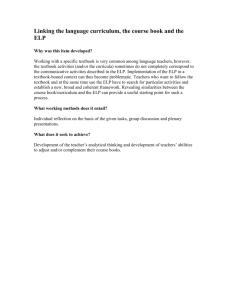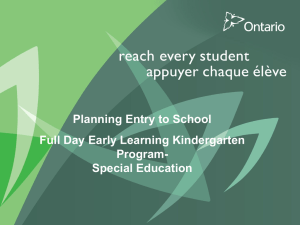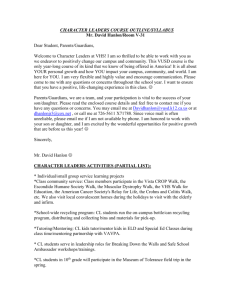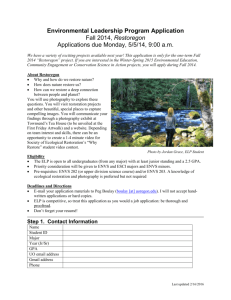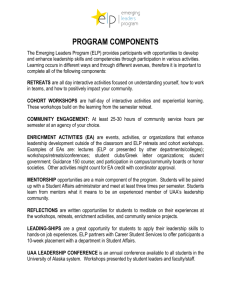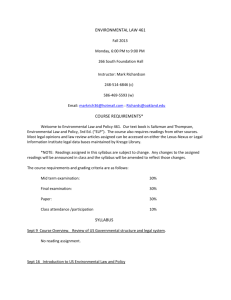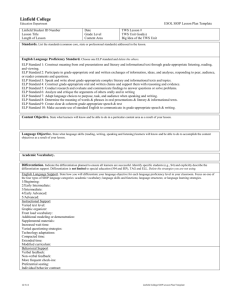Vocabulary Teaching Strategies for ELLs Final 2010
advertisement
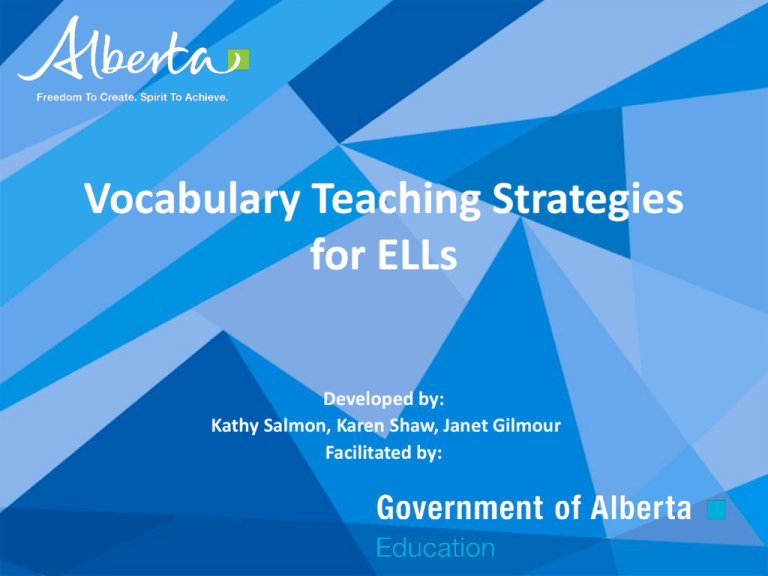
Vocabulary Teaching Strategies for ELLs Developed by: Kathy Salmon, Karen Shaw, Janet Gilmour Facilitated by: Presentation Outline • • • • • • Activating Prior/Background Knowledge – Word Splash What does it mean to know a word? Depth of Word Knowledge Article Jigsaw Getting Ready to Teach Step 1. Identify Key Concepts – Match to learner profile • Step 2. Identify Key Vocabulary – 5 Types of vocabulary Mini – Break 6 minutes • Step 3. Products • Step 4. Content and Process • Step 5. Opportunities for Integrating Vocabulary – Activating Prior Knowledge Mini Break 6 minutes – Explicit Language Instruction – Intentional Recycling – Intentional Spiralling Mini Break 6 minutes • FEEDBACK/EVALUATION Activating Background Knowledge Word Splash 1. On a blank sheet of paper write down the words you know with a definition and/or picture beside it. 2. Draw a line between words that are related. 3. On the line write how they are connected. 4. Write words that you don’t know on the back. 5. Work with a partner and small group – learn, confirm or add to your understanding. Word List 1. Vocabulary 2. Gap 3. Instruction 4. Intervention 5. Conspicuous 6. Context 7. Semantic map 8. Strategic integration 9. Mediated scaffolding 10.Lexicon Activating Prior Knowledge Debrief • What do you do when you don’t know a word? (understanding) • What do you do to learn a new word? (become part of your lexicon) New word learning strategies: -Word analysis -Contextual guessing -Look at visuals -Use a glossary, dictionary, or a thesaurus -Translate -Ask someone Remembering Words: -Intentionally using it -Looking at a reference -Word Association -Picture Association -Repetition in Context -Mnemonic Devices -Making charts, posters, labels All Thumbs! Effective Strategies? The following are good vocabulary teaching strategies –Thumbs up, down or sideways? • • • • • • Hearing the teacher use words Saying the word over and over again Looking at a word and its definition and remembering Looking up words in a dictionary, writing definitions and a sentence Being shown a vocabulary learning strategy and using it independently Matching a picture to the word Activity Created by Gilmour, J., Salmon, K. and Shaw, K. What does it mean to know a word? When you know a word in what ways do you know it? 1. Recognize when you hear it 2. Recognize when you see it 3. Say it 4. Spell it 5. Write it 6. Know a meaning 7. Know a range of meanings 8. Know prefixes and suffixes 9. Know word forms 10.Know grammatical forms Adapted by Kathy Salmon from Cheryl Boyd Zimmerman, Word Knowledge: A Vocabulary Teacher’s Handbook What does it mean to know a word? 11. Know synonyms and antonyms 12. Know typical related words, associations, acronyms, etc. 13. Know cognates 14. Know collocations 15. Know derivatives 16. Know limits of words 17. Know it’s frequency of use 18. Know when to use it (register) 19. Can understand it in different contexts 20. Can use it in many contexts Adapted by Kathy Salmon from Cheryl Boyd Zimmerman, Word Knowledge: A Vocabulary Teacher’s Handbook Depth of Word Knowledge 1. Unknown Word: Students do not recognize the word when they hear or read it. (They may not read yet) 2. Recognition without understanding: Students recognize the word and may be able to pronounce it, but they do not know what it means 3. Basic Word Knowledge: Students have low level of word understanding. The word is understood through reading in context or simple definitions or by listening to an oral explanation. 4. Partial Concept Knowledge: Students have moderate knowledge of the core meaning of the word. Multiple meanings of the word in different contexts and various forms of the word (affixes) are understood through explicit instruction and word play. Students produce forms of the word in their speaking and writing 5. Full Concept Knowledge: Students have full understanding of the word in a variety of overt and implicit contexts . Through exposure to explicit strategies for connecting and extending words students are able to integrate words meaningfully, extend definitions, and play with multiple meanings and word families. Adapted by Kathy Salmon from Kelly Buis, Making Words Stick, 2004. http://www.stenhouse.com/pdfs/8174ch01.pdf All Thumbs! Effective Strategies? The following are good vocabulary teaching strategies –Thumbs up, down or sideways? • • • • • • Hearing the teacher use words Saying the word over and over again Looking at a word and its definition and remembering Looking up words in a dictionary, writing definitions and a sentence Being shown a vocabulary learning strategy and using it independently Matching a picture to the word Activity Created by Gilmour, J., Salmon, K. and Shaw, K. Depth of Word Knowledge - Practice GIMME 5! Rate your knowledge of these words: • School • Recycling • Extemporaneous 1. 2. 3. 4. 5. Unknown Word Recognition without understanding Basic Word Knowledge Partial Concept Knowledge Full Concept Knowledge Adapted by Kathy Salmon from Kelly Buis, Making Words Stick, 2004. http://www.stenhouse.com/pdfs/8174ch01.pdf Article Jigsaw DIRECTIONS - Get in a Home Group of 4 - Number off 1, 2, 3, 4 into your Expert Groups - Get in your Expert Groups - Read the following pages Expert 1 – Pages 1 – 4 Expert 2 – Pages 4 – 7 Expert 3 – Pages 7 -10 Expert 4 - Pages 10 – 13 - Summarize your 3-4 pages - Return to Home Group - Report 3 minutes per expert Reference: “Vocabulary Acquisition: Curricular and Instructional Implications for Diverse Learners” by Scott K. Baker, Deborah C. Simmons, Edward J. Kameenui http://idea.uoregon.edu/~ncite/doc uments/techrep/tech14.html “Vocabulary Acquisition Curricular and Instructional Implications for Diverse Learners.” by Scott K. Baker, Deborah C. Simmons, Edward J. Kameenui. University of Oregon http://idea.uoregon.edu/~ncite/documents/techrep/tech14.html Getting Ready to Teach • Step 1: Identify key concepts (C, P, PContent, process & product) • Step 2: Identify key vocabulary (think 5 types). (C, P, P ) • Step 3: How will learners demonstrate what they know? What is the assessment? (C, P, P) • Step 4: What are the learning experiences? Do they align to the profile of the learners? (C, P, P) • Step 5: Add 4 phases of Vocabulary Instruction to the instructional sequence of the unit (C, P, P) Step 1: Identify Key Concepts Division Example Grade 6 Democracy Key Concepts Democracy Electoral Process Citizenship Evolution of Democracy over time (Historical models of democracy: ancient Athens and the Iroquois Confederacy) Learner Profiles GRADES 4-6 Level 1: Beginning • Understands and uses basic words in simple sentences. Level 2: Developing • Understands and uses more familiar, descriptive and some academic words in simple sentences. Level 3: Expanding • Understands and uses some descriptive and academic words in longer detailed sentences. Level 4: Bridging • Understands and uses more descriptive and academic words in complex sentences. Level 5: Expanding • Understands and uses a range of synonyms, antonyms, adjectives and adverbs in a variety of sentence structures. Step 1: Identify Key Concepts – Practice Division Example Key Concepts Democracy Electoral Process Citizenship Evolution of Democracy over time (Historical models of democracy: ancient Athens and the Iroquois Confederacy) • Identify aspects of the key concepts and levels of language ELL’s will use to demonstrate their understanding. Step 1: Identify Key Concepts - Practice For an upcoming unit that you will be teaching identify the Key Concepts • Identify aspects of the key concepts and levels of language ELL’s will use to demonstrate their understanding of the key concepts. Step 2: Identify Vocabulary 5 Types of Vocabulary • Subject specific- can also be in context-defined • Context-defined –multiple meanings- transferable words across subjects e.g.; “role”, noun clusters; e.g., ”global warming” • Academic Words – language of thinking processes required to do academic tasks; e.g., “ compare”, “contrast” • Connectors – words and phrases used to show the relationship of ideas; e.g., ”whereas”, “the most important” • Figurative Language – words that go beyond the literal meaning Step 2: Identify Vocabulary Division Example 5 Types of Vocabulary Practice • Subject specific • Context-defined • Academic Words • Connectors • Figurative Language Compare Premier However Federal Democracy Put your foot down …differs from… Bill Treaty Role Election Campaign Explain Read this sentence and identify words which represent the following vocabulary types In a democracy, citizens take a responsible role to speak up about government decisions, however some citizens will put their foot down and clearly explain why they think their opinion is best for the country. • Subject specific • Context-defined • Academic Words • Connectors • Figurative Language Step 2: Identify Vocabulary Division Exampled 5 Types of Vocabulary Practice • Subject specific • Context-defined • Academic Words • Connectors • Figurative Language “ In a democracy, citizens take a responsible role to speak up about government decisions, however some citizens will put their foot down and clearly explain why they think their opinion is best for the country.” Step 2: Identify Vocabulary Division Example 5 Types of Vocabulary Practice Subject specific- government, provincial, federal, democracy, treaty, election, confederacy, mayor, alderman, premier, prime minister, local, municipal, citizens, historical, physical, political, vote, petition, Canadian Charter of Rights and Freedoms, by-laws, equity, fairness, justice, identity, consensus, campaign, bill Context-defined –local, election, issues, vote, by-laws, equity, fairness, justice, identity, consensus, press, block, news story, press release, checks and balances, bill, change, role, volunteer, premier Academic Words – recognize, compare, contrast, point-of view, bias, opinion Subject Specific Vocabulary for ELP levels government, provincial, federal, democracy, treaty, election, confederacy, mayor, alderman, premier, prime minister, local, municipal, citizens, historical, physical, political, vote, petition, Canadian Charter of Rights and Freedoms, by-laws, equity, fairness, justice, identity, consensus, campaign, bill Which words for which level? ELP 1/2 citizen, vote, politics, party, election, provincial, law ELP 3 democracy, treaty, campaign, by-laws, fairness, equity, identity ELP 4/5 confederacy, alderman, municipal, petition, Charter of Rights and Freedoms, consensus, justice Step 2: Identify Vocabulary Division Example 5 Types of Vocabulary Practice Connectors – in both cases, however, similar, difference, is like, is differs from, also, as well, on the other hand, in contrast, while, unlike Figurative Language – • “beating around the bush” • “get off the hook” • “more than meets the eye” • ”put your foot down” • “pull the wool over your eyes” • “make a federal case out of something” • “roast” • “on the fence” • “in the doghouse” • “put all your eggs into one basket” • “head of state” Step 2: Practice Identifying Key Vocabulary • For an upcoming unit that you will be teaching identify key vocabulary. • Subject specific • Context-defined • Academic Words • Connectors • Figurative Language Step 3: Select Appropriate Products POSSIBLE PRODUCTS Diagrams Dioramas Posters Plays Power Points I Movie Essays Newspapers Website Cartoons Brochures Stories Letter Poems Personal Dictionaries Art work Musical Works Debate Advertisement Survey Simulation Photo Essay Dance Created object (baked, sewn, modeled, sculpted, built etc. Adapted by K. Salmon from C.Tomlinson Game Multi-media Video Charts Graphs Display Demonstration Data Collection Data Analysis Collection of resources Collection of objects, images etc. Step 4: Select Appropriate Content and Processes for Learning POSSIBLE CONTENT • • • • • • • • • • • • • Videos Demonstrations Experiments Presentation Lecture Books Websites Digital Media Discussion Realia Visuals Maps Case Studies POSSIBLE PROCESS POSSIBLE PROCESS • • • • • • • • • • • • • Matching Sorting Calculating Problem solving Graphic Organizers Timelines, graphs, chart, picture etc. interpretations Cooperative Groups: Literature Circles, Reciprocal Teaching, QAR, Focused Conversations • • Guided Reading Writing Process Research Inquiry process Interview, survey Planning projects, processes to complete products Building structures etc. Creating objects, art, music, drama 3 Opportunities for Integrating Vocabulary Learning Strategies Activating Prior Knowledge Explicit Language Instruction Intentional Recycling Activating Prior Knowledge What is it? • Prior knowledge is a combination of a learner's preexisting attitudes, experiences, and knowledge. Why is it important? • A student’s schema, or knowledge of the world, affects his or her understanding of subject matter and provides a framework to help make sense of new information. • Prior knowledge also assists students with recall, enabling them to elaborate upon a topic. • Prior knowledge allows students to make inferences about their reading and directs their attention to important information. http://www.alaskacc.org/ELLPriorKnowledge Building Background Knowledge What is it? • Building background knowledge is necessary when the student has limited or no prior attitudes, experiences or knowledge. Why is it important? • A student’s schema, or knowledge of the world, affects his or her understanding of subject matter and provides a framework to help make sense of new information and therefore it is important to create a base of knowledge and experience for students to build a schema and develop a framework for thinking. http://www.alaskacc.org/ELLPriorKnowledge Strategies for Activating Prior Knowledge • KWL • Brainstorming: facts, ideas, opinions, misconceptions, questions • Asking questions to determine knowledge • Word Splash (Semantic Mapping) • Interpretations of pictures • Interactive discussions/interactive lectures http://www.cast.org/publications/ncac/ncac_backknowledg e.html http://www.alaskacc.org/ELLPriorKnowledge Strategies for Building Background Knowledge • Pre-teach vocabulary • Provide an interactive learning experience including • Realia • Demonstration • Exploration • Video • Story • Field trip etc. • Provide: • definitions of difficult vocabulary, • translations of foreign phrases, explanations of difficult concepts. • previews of narrative texts that included a plot synopsis, descriptive list of characters, and definitions of difficult words in the story. • Opportunities for reflection and recording http://www.cast.org/publications/ncac/ncac_backknowledge.html http://www.alaskacc.org/ELLPriorKnowledge Division Example for Activating Prior Knowledge Activating Prior Knowledge: Connect student’s prior knowledge to the concept of “citizenship”. Student Responses: Strategy: Brainstorming • Question to students: How is citizenship demonstrated at school? • • • • • • • • We take turns. We share. We clean the school yard. We are making a garden for our school. We are turning off the lights and computers. We have class jobs. We make decisions on student council. We vote on class events. We belong to choir, intramurals, chess club etc. Division Example for Activating Prior Knowledge - Align to ELP Which ELP level would make these comments during the brainstorming? • • • • • • • • • We take turns. We share. We clean the school yard. We are making a garden for our school. We are turning off the lights and computers. We have class jobs. We make decisions on student council. We vote on class events. We belong to choir, intramurals, chess club etc. Division Example – Building Background Knowledge - Align to ELP • Select a book to read to the class on citizenship like “Tops and Bottoms” by Janet Stevens. • Hold a class discussion about citizenship. • Then re-connect to list class brainstormed and review how those items are examples of being a good citizen. Practice: Building Background Knowledge • Think of an upcoming unit that you will be teaching. Select the most appropriate building background knowledge activity. • Modify and adapt the activity to your context. • Think about the ELP of your students and modify accordingly. Practice: Activating Prior Knowledge • Select one of the Activating Prior Knowledge or Building Background Knowledge Strategies. • Create a visual that explains or is an example of that strategy. • Identify the ELP level of this strategy. Interpretation of a picture BREAK Six minutes! Listen to the music for your cue to return . 3 Opportunities for Integrating Vocabulary Learning Strategies Activating Prior Knowledge Explicit Language Instruction Intentional Recycling Explicit Language Instruction What is it? • Explicit Language Instruction is also known as direct teaching. It often involves vocabulary, grammar, syntax, conventions etc. It is most effective when it is taught in context. Why is it Important? • ELLs at all proficiency levels require explicit language instruction, practice and feedback as they are acquiring English. • Note: Learning vocabulary is not just bound to the word level – it is about making or understanding meaning in the context. (Depth of Word Knowledge) Strategies for Explicit Language Instruction • Labeled pictures, diagrams, charts, graphs, maps (visual with words and definitions) • 3, 4, 5, 6, 7 Point Models: (word, picture, definition, synonym, sentence, example, non-example) • Flash Cards (word, picture, definition) • Anchor Charts (group generated chart of new words, pictures, and how they are related) • Word Analysis (affixes, derivations, connotations) • Categorizing (Sorting into labeled charts) • Matching (synonyms, antonyms, definitions) • Relating (Grids (matrix with meanings and word features), Clines (words on a continuum to show degree), Clusters (words grouped around an idea) Division Example for Explicit Language Instruction To learn about an election Strategy – Anchor Chart 1. Read “Vote” for Duck by Doreen Cronin with students. 2. Pause at various points to collect relevant words on a chart with a picture and synonym or simple definition e.g. (election, vote, poster, register, ballot, polling booths, tally votes, results, campaign). 3. After reading the book, discuss what happened to duck. Encourage students to use the words from the chart as they share their ideas. Write down the sequence of the story as the students tell it. Have students re-tell the story to partners to practice using the words. 4. Create an anchor chart which shows the words, meanings and relationships. Division Example – Anchor Chart for Explicit Language Instruction •Candidate •Speech •Posters •parades •Candidates •Registered voters •Ballot •Polling booth •Voters •Tally •results Campaign Voting Election Voters •Citiizens •Valid ID •Register •Polling Booth •Mark ballot Division Example for Explicit Language Instruction Strategy – Word Analysis - Affixes Word: Elect • Verb – Elect – Elected – Electing – Re-elect • Noun – Election • Adjective – Elected party – Electoral Candidate WORD WALL for Explicit Language Instruction There is an expectation that all students will understand the concepts, however vocabulary expectations will differ; e.g. An example of “democracy” for an ELP one might be “fairness”. ELP five may use the word “equity” whereas an ELP one would use the term “equal”. Teachers can maintain on-going vocabulary as classroom artifacts through the use of a word wall. The purpose is for students to use as a reference. Target Words for ELP levels ELP One – “vote” “mayor” “fair” “equal” ELP Two – “government” “citizen” ELP Three – “local” ,”provincial”, “federal” ELP Four –”democracy” ELP Five – equity Practice • Select one of Explicit Language Instruction Strategies. • Model the strategy. (Pick words to use with the strategy). • Think about the words that you want to teach and the suitability of the strategy. i.e. ‘often’ is best taught in a cline: never, rarely, sometimes, often, always • If teaching nouns a suitable strategy would be to use flash cards as demonstrated below. 3 Opportunities for Integrating Vocabulary Instruction into a Learning Experience Activating Prior Knowledge Explicit Language Instruction Intentional Recycling Intentional Recycling What is it? • Recycling is the intentional repetition of key vocabulary throughout the unit. Why is it Important? • Students must be exposed to words 50-80 times and use it 7 times for it to become part of their lexicon. • Students must be provided prompts, scaffolds and expectations to use new vocabulary. • Note: Students learn new vocabulary with the teacher, they practice using the vocabulary with scaffolding and then to independence. Strategies for Intentional Recycling Word Play • Odd man out • Close exercises with word banks • Word search • Crossword puzzles • Games: who am I? Hang man, Jeopardy, Riddles • Mnemonic Devices Instructional Opportunities • Spelling, Dictation • Journals • Seek, find, replace (Jail words, Said is dead) • Word wall, anchor charts • Models and Templates • Graphic Organizers (Venn Diagrams, Frayer Model, Tcharts, Timelines, Narrative and Expository Planners) Strategies for Intentional Recycling • Word Wall with 3-point Strategy, a visual, a • synonym/example and a definition Division Example for Recycling: Classroom Talk supported with scaffolds • Use the language of democracy and citizenship in everyday classroom experiences; e.g.; Teacher selects two to three target words (“premier”, “citizens, “change”) to be used throughout the day during everyday classroom conversations. The teacher may say, “As your premier today, I will be asking you as citizens to investigate some premier changes for class dismissal.” • To accommodate various ELP levels a teacher may use visual cues to support understanding. e.g., point to the printed word, gestures, visuals. • Teacher expectations of student responses will differ according to the ELP level. Division Example for Recycling: Classroom Talk supported with scaffolds Have students use specific language to engage as positive citizens in a class meeting to make a decision about playground equipment. Teacher asks question: Who votes us sharing the equipment? Students respond with: Making a Democratic Decision • ELP Level 1 & 2 – “I say yes.” • ELP Level 3 – “I have decided to vote yes for sharing the equipment.” • ELP Level 4 – “ I will vote no for sharing the equipment because some students are not sure what “share” means”. • ELP Level 5 – “I will make a chart to show how we will share the three kinds of equipment we have.” Practice: Intentional Recycling • Select a Recycling Strategy. • Share what the strategy is and how you would use this strategy effectively. Describe Strategy • Different word searches and crossword puzzles can be created for various ELP Levels They can be used as independent practice when students have finished their work, and/or for homework. • Record on a chart supports/adjustments for ELP levels 1-5 for the strategy. ELP 1 ELP 2 ELP 3 ELP 4 ELP 5 BREAK Six minutes! Listen to the music for your cue to return . 4 Opportunities for Integrating Vocabulary Strategies into a Learning Experience Activating Prior Knowledge Explicit Language Instruction Intentional Recycling Intentional Spiraling Intentional Spiraling What is it? • Intentional Spiraling is expanding word knowledge and applying word knowledge in new contexts Why is it important? • It involves students being able to use and understand words and make connections in different subjects as well as in their personal life experiences. • Note: Lower proficiency students may not get to this phase. Some younger students may not be at the developmental stage to expand or extend word knowledge. Some older students with limited proficiency may need additional scaffolds to expand or extend their word knowledge. Strategies for Intentional Spiraling Word Play • Muddled Sentences • Gapped Text • Ghost Definitions • 5, 4, 3 Technique • Deconstruction Instructional Opportunities • Affixes • Word Family Grid • Grids, Clines and Clusters • Word Splash • Writing • Projects Division Example for Intentional Spiraling Students demonstrate application of the concept of “citizenship” in a new context e.g.; “responsibility to be good citizens of the environment”. ELP One – Create posters for the school demonstrating environmental responsibility and respect for the classroom, school and playground. Students will be encouraged to use words from classroom references. ELP Two – A teacher assigns a student to playground clean-up. The student is expected to independently ask other students to help with the cleanup and to approach office staff to request clean-up supplies. ELP Three - The student will explain to fellow classmates why it is important to take care of our environment. ELP Four – The student will visit other classrooms to speak to fellow students about pride in keeping a tidy playground and school. ELP Five – Students will write skits and collaborate with fellow students to use for PA. announcements and/or for performance in assemblies. E.g., How to protect our environment and be a global citizen in caring for our world. Return to Word Splash Word Splash 1. On a blank sheet of paper write down the words you know with a definition and/or picture beside it. 2. Draw a line between words that are related. 3. On the line write how they are connected. 4. Write words that you don’t know on the back. 5. Work with a partner and small group – learn, confirm or add to your understanding. Word List 1. Vocabulary 2. Gap 3. Instruction 4. Intervention 5. Conspicuous 6. Context 7. Semantic map 8. Strategic integration 9. Mediated scaffolding 10.Lexicon All Thumbs Up! Use the information from the session. How do you make these strategies better? • • • • • • Hearing the teacher use words Saying the word over and over again Looking at word and definition and remembering Looking up words in a dictionary, writing definitions and write a sentence Being shown a vocabulary learning strategy and using it independently Matching a picture to the word Activity Created by Gilmour, J., Salmon, K. and Shaw, K. Conclusion: Independent Word Learning Strategies for Students Question to Ponder??? Ask yourself: Through the vocabulary strategies I am teaching, what level of independence are ELLs achieving in word learning? Evaluation Please complete the “Program Feedback & Ongoing Needs Assessment 2009- 2010” for the Calgary Regional Consortium.
